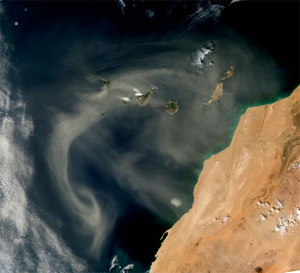- STAR Home
- > 2009
News
- > STAR Scientists' Work Links Sea Surface Temperature and Atmospheric Dust
STAR Scientists' Work Links Sea Surface Temperature and Atmospheric Dust

March 11, 2009 - Over the last few decades, sea surface
temperatures (SST) in the Atlantic Ocean have increased
significantly. Much recent research has demonstrated the link
between increased Hurricane Intensity and increased SST. Work at
the University of Wisconsin using NESDIS data sets has shown that
since 1980, the amount dust flowing out over the Atlantic Ocean
from the Saharan Desert has also decreased dramatically. A recent
study published in Science led by Amato Evan and including
Andrew Heidinger and James Kossin of NESDIS shows that dust
accounts for much of the observed SST variability, as well as the
positive SST trend in the region of the Atlantic Ocean where most
Hurricanes form. Because the presence of dust acts to cool the
ocean surface, a decrease in dust causes an increase in SST. This
study highlights the importance of long-term satellite data sets
in observing the complex and sometimes unexpected mechanisms that
control the earth's climate. The data set used in this study was
the NESDIS PATMOS-x (Pathfinder Atmospheres Extended) generated
from the 30 years of Advanced Very High Resolution Radiometer
(AVHRR) data on the POES platform.
|

